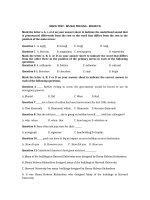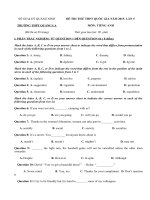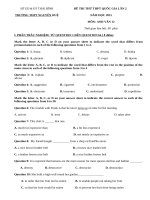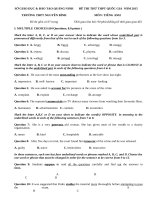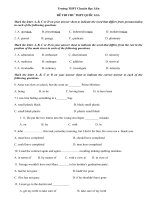Đề thi thử THPTQG môn Tiếng Anh (đề số 20)
Bạn đang xem bản rút gọn của tài liệu. Xem và tải ngay bản đầy đủ của tài liệu tại đây (100.99 KB, 4 trang )
SỞ GIÁO DỤC VÀ ĐÀO TẠO
TỈNH NINH BÌNH
ĐỀ THI CHÍNH THỨC
(Đề thi gồm có 04 trang)
ĐỀ THI THỬ THPT QUỐC GIA
CHO HỌC SINH (HỌC VIÊN) LỚP 12 THPT, BT THPT
NĂM HỌC 2016-2017
Môn: TIẾNG ANH
Thời gian làm bài: 60 phút, không kể thời gian phát đề
Mã đề thi 202
Họ tên thí sinh: ............................................; Số báo danh: ......................................
Mark the letter A, B, C or D on your answer sheet to indicate the sentence that best combines each
pair of sentences in the following questions.
Question 1: Anne jogs every morning. It is very good for her health.
A. Anne jogs every morning and is very good for her health.
B. Anne jogs every morning, which is very good for her health.
C. Anne jogs every morning and then it is very good for her health.
D. Anne jogs every morning that it is very good for her health.
Question 2: I did not read his book. I did not understand what the lecturer was saying.
A. I found it very difficult to understand what the lecturer said in his book.
B. The lecturer's book which I had not read was difficult to understand.
C. What the lecturer wrote and said was too difficult for me to understand.
D. I would have understood what the lecturer was saying if I had read his book.
Mark the letter A, B, C or D on your answer sheet to indicate the sentence that is closest in meaning
to each of the following questions.
Question 3: The doctor said, “You really ought to rest for a few days, Jasmine”
A. It is doctor’s recommendation that Jasmine rested shortly.
B. The doctor strongly advised Jasmine to take a few days’ rest.
C. The doctor advised Jasmine not to take a short rest.
D. Jasmine’s doctor insisted that she should rest for a few days.
Question 4: She raised her hand high so that she could attract the teacher’s attention.
A. Because her teacher attracted her, she raised her hand again.
B. Though she raised her hand high, she couldn’t attract her teacher’s attention.
C. To attract her teacher’s attention, she raised her hand high.
D. She had such a high raising of hand that she failed to attract her teacher’s attention.
Question 5: You should have persuaded him to change his mind.
A. You persuaded him to change his mind but he didn’t listen.
B. If I were in your place, I would persuade him to change his mind.
C. You didn’t persuade him to change because of his mind.
D. It was essential to persuade him to change his mind but you didn’t.
Mark the letter A, B, C, or D on your answer sheet to indicate the word that differs from the other three
in the position of the primary stress in each of the following questions.
Question 6: A. biologist
B. economics
C. certificate
D. ability
Question 7: A. involve
B. explain
C. purpose
D. advise
Mark the letter A, B, C, or D on your answer sheet to indicate the correct answer to each of the
following questions.
Question 8: My sister is _________ seafood, so she never tries these delicious dishes.
A. allergic to
B. tired of
C. keen on
D. preferable to
Question 9: The suspect is believed_________ by the police some days ago.
A. to being released
B. to be released
C. having released
D. to have been released
Question 10: Many plants and animals are now under threat of _________.
A. expulsion
B. extension
C. expression
D. extinction
Question 11: Learning English isn’t so difficult once you _________.
A. get down to it
B. get off it
C. get down with it
D. get on it
Question 12: In American culture, people avoid asking someone about age, _________ , and salary because
this is considered impolite.
A. marry
B. married
C. marrying
D. marriage
Trang 1/4 - Mã đề thi 202
Question 13: It was one of _________ I’ve ever seen.
A. most boring films
B. the film more borings C. the more boring films D. the most boring films
Question 14: It never _________ his mind that his dishonesty would be discovered.
A. crossed
B. came
C. spunk
D. passed
Question 15: When you come out of the lift, you will see two doors, a red one and a blue one. My door is
_______ blue.
A. an
B. ø
C. a
D. the
Question 16: The policeman wanted to know where he _________.
A. had been the last night
B. was the night before
C. was last night
D. had been the previous night
Question 17: Because I was short _________ money to buy a book yesterday, I had to borrow some from my
friend.
A. in
B. at
C. of
D. on
Question 18: By the end of next week, John ________ French for 5 months.
A. will have learnt
B. would learn
C. will have
D. has learnt
Question 19: We’d better _________ early so as to avoid the heavy traffic.
A. come apart
B. set off
C. take up
D. go about
Mark the letter A, B, C, or D on your answer sheet to indicate the word whose underlined part differs
from the other three in pronunciation in each of the following questions.
Question 20: A. likes
B. laughs
C. hopes
D. lives
Question 21: A. fly
B. society
C. geography
D. sandy
Read the following passage and mark the letter A, B, C, or D on your answer sheet to indicate the
correct answer to each of the questions.
Basic to any understanding of Canada in the 20 years after the Second World War is the country’s
impressive population growth. For every three Canadians in 1945, there were over five in 1966. In September
1966 Canada’s population passed the 20 million mark. Most of his surging growth came from natural
increase. The depression of the 1930’s and the war had held back marriages, and the catching-up process
began after 1945. The baby boom continued through the decade of the 1950’s, producing a population
increase of nearly fifteen percent in the five years from 1951 to 1956. This rate of increase had been
exceeded only once before settled. Undoubtedly, the good economic condition of the 1950’s supported a
growth in the population, but the expansion also derived from a trend toward earlier marriages and an
increase in the average size of families. In 1957 the Canadian birth rate stood at 28 per thousand, one of the
highest in the world.
After the peak year of 1957, the birth rate in Canada began to decline. It continued failing until in 1966
it stood at the lowest level in 25 years. Partly this decline reflected the low level of births during the
depression and the war, but it was also caused by changes in Canadian society. Young people were staying
at school longer; more women were working; young married couples were buying automobiles or houses
before starting families; rising living standards were cutting down the size of families.
It appeared that Canada was once more falling in step with the trend toward smaller families that had
occurred all through the Western world since the time of the Industrial Revolution.
Although the growth in Canada’s population had slowed down by 1966 ( the increase in the first half of
the 1960’s was only nine percent), another large population wave was coming over the horizon. It would be
composed of the children who were born during the period of the high birth rate prior to 1957.
Question 22: What does the passage mainly discuss?
A. Canada during the Second World war.
B. Population trends in postwar Canada.
C. Educational changes in Canadian society.
D. Standards of living in Canada.
Question 23: According to the passage, when did Canada’s baby boom begin?
A. In 1966
B. After 1945
C. In the decade after 1911
D. During the depression of the 1930’s
Question 24: The word “five” refers to_________.
A. marriages
B. years
C. decades
D. Canadians
Question 25: The word “surging” is closest in meaning to_________.
A. accelerating
B. surprising
C. new
D. extra
Question 26: The author suggests that in Canada during the 1950’s_________.
A. the birth rate was very high
B. fewer people married
C. economic conditions were poor
D. the urban population decreased rapidly
Question 27: The word “peak” is closest in meaning to_________.
A. pointed
B. dismal
C. maximum
D. mountain
Trang 2/4 - Mã đề thi 202
Question 28: The author mentions all of the following as causes of declines in population growth after 1957
EXCEPT_________.
A. couples buying houses
B. better standards of living
C. people getting married earlier
D. people being better educated
Question 29: It can be inferred from the passage that before the Industrial Revolution_________.
A. population statistics were unreliable
B. families were larger
C. the population grew steadily
D. economic conditions were bad
Read the following passage and mark the letter A, B, C, or D on your answer sheet to indicate the
correct word or phrase that best fits each of the numbered blanks.
After a busy day of work and play, the body needs to rest. Sleep is necessary for good health. During
this time, the body recovers from the (30) ________ of the previous day. The rest that you get while sleeping
makes it possible for your body to prepare itself for the next day.
There are four levels of sleep, each being a little (31)_______ than the one before. As you sleep,
your body relaxes little by little. Your heart beats more slowly, and your brain slows down. After you
(32)_______ the fourth level, your body shifts back and forth from one level to the other.
Although your mind slows down, you will dream from time to time. Scientists who study sleep point out
that when dreaming (33)_______, your eyeballs begin to move more quickly (although your eyelids are
closed). This stage of sleep is called REM, which stands for Rapid Eye Movement.
If you have trouble falling asleep, some people recommend breathing very slowly and very deeply.
Other people believe that drinking warm milk will make you (34)_______. There is also an old suggestion that
counting sheep will put you to sleep.
Question 30: A. actions
Question 31: A. higher
Question 32: A. attain
Question 33: A. exists
Question 34: A. awake
B. activities
B. deeper
B. reach
B. survives
B. drowsy
C. acting
C. shorter
C. arrive
C. occurs
C. tired
D. acts
D. lighter
D. achieve
D. appears
D. dizzy
Mark the letter A, B, C or D on your answer sheet to indicate the word(s) CLOSEST in meaning to the
underlined word(s) in each of the following questions.
Question 35: Governments have enacted laws to protect wildlife from commercial trade and hunting.
A. introduced
B. organized
C. given
D. develop
Question 36: This is the instance where big, obvious non-verbal signals are appropriate.
A. situation
B. attention
C. place
D. matter
Mark the letter A, B, C or D on your answer sheet to indicate the word(s) OPPOSITE in meaning to the
underlined word(s) in each of the following questions.
Question 37: Doctors of medicine are among the wealthy members of American society.
A. affluent
B. adjacent
C. acrid
D. poor
Question 38: I think we can safely say now that we have got our money back, we are home and dry.
A. have got no water
B. have not got wet
C. have got home dry
D. have been unsuccessful
Read the following passage and mark the letter A, B, C, or D on your answer sheet to indicate the
correct answer to each of the questions.
Aspirin’s origins go back at least as early as 1758. In that year, Englishman Edward Stone noticed a
distinctive bitter flavor in the bark of the willow tree. To Stone, this particular bark seemed to have much in
common with “Peruvian Bark”, which had been used medicinally since the 1640s to bring down fevers and to
treat malaria. Stone decided to test the effectiveness of the willow bark. He obtained some, pulverized it into
tiny pieces, and conducted experiments on its properties. His tests demonstrated that this pulverized willow
bark was effective both in reducing high temperatures and in relieving aches and pains. In 1763, Stone
presented his findings to the British Royal Society.
Several decades later, further studies on the medicinal value of the willow bark were being conducted by
two Italian scientists. These chemists, Brugnatelli and Fontana, determined that the active chemical that was
responsible for the medicinal characteristics in the willow bark was the chemical salicin, which is the active
ingredient of today’s aspirin.
The name “aspirin” is the trade name of the drug based on the chemical salicin, properly known as
acetylsalicylic acid. The trade name “aspirin” was invented for the drug in the 1890s by the Bayer Drug
Company in Germany. The first bottles of aspirin actually went on sale to the public just prior to the turn of the
century, in 1899.
Trang 3/4 - Mã đề thi 202
Question 39: According to the passage, aspirin originated_________.
A. definitely sometime in 1758
B. no earlier than 1978
C. no later than 1758
D. sometime after 1758
Question 40: The pronoun “it” in the first passage refers to _________.
A. malaria
B. the British Royal Society
C. willow bark
D. effectiveness
Question 41: The word “properties” in the first paragraph could best be replaced by_________.
A. materials
B. characteristics
C. ownership
D. body
Question 42: What did the willow bark look like after Stone prepared it for his experiments?
A. It was in strips of bark
B. it was a rough powder
C. It was in large chunks
D. it was a thick liquid
Question 43: The Italian chemists mentioned in the passage most probably conducted their studies on
willow bark.
A. in the 1750s
B. in the 1770s
C. in the 1780s
D. in the 1760s
Question 44: What is true about Brugnatelli and Fontana?
A. They conducted studies on the willow bark.
B. They were not from Italy.
C. They added a chemical to the pillow bark.
D. They were medical doctors.
Question 45: The word “turn” in the last paragraph could best be replaced by_________.
A. reversal
B. spin
C. change
D. corner
Mark the letter A, B, C or D on your answer sheet to indicate the most suitable response to
complete each of the following exchanges.
Question 46: Nga and Minh have just taken their exam.
- Nga: “This exam is the hardest one we’ve ever had this semester.”
- Minh: “_____________. But I think it’s quite easy.”
A. I understand what you’re saying
B. I don’t see in that way
C. I couldn’t agree more
D. You’re right
Question 47: Alfonso and Maria are discussing about the Jeffersons.
- Alfonso: “What do you think of the Jeffersons?”
- Maria: “_____________.”
A. Although they appeared reserved at first, they are very sociable
B. Oh, I don’t think of them
C. No, it’s very kind of them to have an outgoing personality
D. Oh, they are not having the choice
Mark the letter A, B, C, or D on your answer sheet to indicate the underlined part that needs
correction in each of the following questions.
Question 48: Either Mr. Anderson or Ms. Wiggins are going to teach our class today.
A
B
C
D
Question 49: The major goals of primary education is to achieve basic literacy and numeracy among all
students.
A
B
C
D
Question 50: A food additive is any chemical that food manufacturers intentional add to their products.
A
B
C
D
----------THE END-----------
Trang 4/4 - Mã đề thi 202

